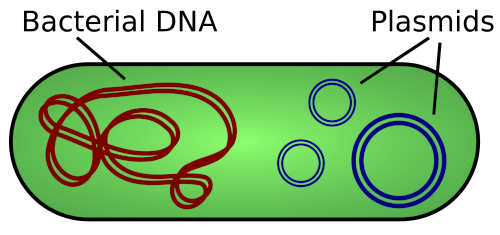Virtual Genetics Education Centre
Microbial genomes for schools and colleges
Genome is the word we use to describe all of an organism's DNA, including its chromosomes and any other pieces of DNA it may have acquired.The genomes of many microorganisms are very different from those of human genomes and we'll discuss a few of these differences here.
You will see on the DNA, Genes and Chromosomes page that human DNA is arranged into 46 chromosomes which are found in every cell and contain all of the information required to make a person. Most bacteria usually contain only one, circular chromosome carrying all of the genes essential to its life cycle. One way in which bacterial genomes differ from human genomes is that in addition to their chromosomal DNA they often carry additional pieces of circular DNA that code for non-essential functions. These circular pieces of DNA are called plasmids. Plasmids can code for a variety of non-essential proteins, for example enzymes that allow bacteria to resist antibiotic treatment.

Bacterial genomes are often far smaller than eukaryotic genomes and vary widely between species. For example, the smallest bacterial genome is found in Mycoplasma genitalium and is made up of 580,070 base pairs coding for 525 different genes which is tiny when you compare it to the 300,000,000 (3 billion) base pairs coding for roughly 25,000 genes in human genomes.
Mycoplasma genitalium has the smallest bacteria genome containing just 525 genes.
How do we study microbial genomes?
In the last decade, studying microbial genomes has become far easier with the discovery and development of a range of DNA sequencing technologies. DNA sequencing allows us to identify the base pairs making up a piece of DNA. These advancements mean we can now sequence entire genomes relatively easily. This is particularly useful for several reasons:
- It allows us to predict the function of genes and what the resulting phenotypes may be. Many of these genes allow bacteria to cause disease.
- It allows us to compare the organisation of genomes between different organisms. These comparisons help us to map evolutionary relationships, and decipher the origin of specific genes and their transfer between strains by horizontal gene transfer